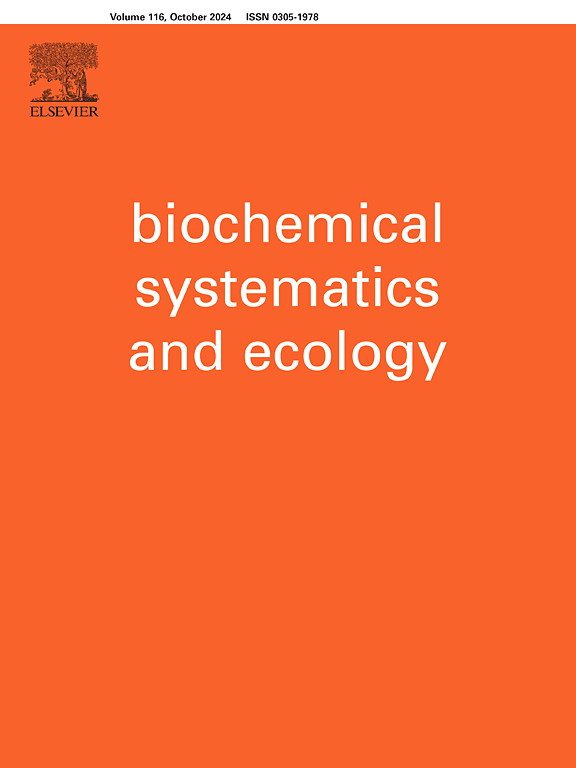Graphical analysis of multi-environmental trials for rose scented geranium (Pelargonium graveleons L'H'er.L'Herit ex Ait) essential oil yield using GGE biplot analysis
IF 1.4
4区 生物学
Q4 BIOCHEMISTRY & MOLECULAR BIOLOGY
引用次数: 0
Abstract
Rose-scented geranium is an important aromatic crop producing essential oils in India. The study was undertaken during the 2022–23 to 2023–24 cropping seasons at the CSIR-CIMAP, Lucknow, India (80°28′ E 26018 N, 49 m above sea level). The present investigation tried to analyze the GEI in geranium genotypes using the graphical approach of the GGE biplot and to identify lines with good reliability and performance. Geranium cultivars Bourbon, Algerian, CIM-Pawan, Kelkar, CIM-Bharat, and CIM-BIO 171 were examined in multi-year experiments on the Institute's farm using normal production procedures. Six geranium genotypes were grown and analyzed for two years using the GEI-based GGE Graphical biplot technique. There was significant variation among the geraniums in terms of mean yield, performance, and stability, indicating that the bi-plot approach helped with genotype discrimination under varied conditions. In the present investigation, the trait X1 (leaf length) is highly significant and positively correlated with traits such as X2 (leaf width), X3 (leaf area), X4 (leaf node length), X5 (petiole length), X6 (leaf weight), and X7 (leaf yield per plant), but negatively correlated with X8 (essential oil recovery) and X9. The feature X2 is vital and correlates positively with qualities X3, X4, X6, and X7. The two qualities, X8 and X9, were negatively correlated with X2. PC1 and 2 accounted for more than 77.9% of the yield performance variation. GGE biplot analysis revealed that CIM Bio 171 and CIM Bharat outperformed other genotypes regarding stability and mean essential oil yield. In contrast, the Bourbon genotype showed the least amount of yield stability. Thus, genotypes CIM Bio 171 and CIM Bharat will be confirmed and released for large-scale geranium production in India.

蔷薇天竺葵(Pelargonium graveons L' her)多环境试验的图形分析。L'Herit ex Ait)精油收率使用GGE双图分析
玫瑰天竺葵是印度重要的香薰作物。该研究于2022-23至2023-24种植季在印度勒克瑙CSIR-CIMAP(80°28′E 26018 N,海拔49 m)进行。本研究试图利用遗传基因双标图的图解方法分析天竺葵基因型的遗传基因i,并找出可靠性和性能良好的品系。天葵品种Bourbon、Algerian、CIM-Pawan、Kelkar、CIM-Bharat和CIM-BIO 171在研究所农场采用常规生产程序进行了多年试验。使用基于gei的GGE图形双图技术对6种天竺葵基因型进行了两年的生长和分析。在平均产量、性能和稳定性方面,天竺葵品种之间存在显著差异,表明双图方法有助于在不同条件下进行基因型区分。在本研究中,X1(叶长)性状与X2(叶宽)、X3(叶面积)、X4(叶节长)、X5(叶柄长)、X6(叶重)、X7(单株叶产量)性状呈极显著正相关,与X8(精油回收率)、X9呈负相关。特性X2非常重要,并且与特性X3、X4、X6和X7呈正相关。X8和X9两个品质与X2呈负相关。PC1和pc2占产量性状变异的77.9%以上。GGE双图分析显示,CIM Bio 171和CIM Bharat在稳定性和平均精油产量方面优于其他基因型。相比之下,波旁基因型表现出最少的产量稳定性。因此,基因型CIM Bio 171和CIM Bharat将被确认并发布,用于在印度大规模生产天竺葵。
本文章由计算机程序翻译,如有差异,请以英文原文为准。
求助全文
约1分钟内获得全文
求助全文
来源期刊

Biochemical Systematics and Ecology
生物-进化生物学
CiteScore
3.00
自引率
12.50%
发文量
147
审稿时长
43 days
期刊介绍:
Biochemical Systematics and Ecology is devoted to the publication of original papers and reviews, both submitted and invited, in two subject areas: I) the application of biochemistry to problems relating to systematic biology of organisms (biochemical systematics); II) the role of biochemistry in interactions between organisms or between an organism and its environment (biochemical ecology).
In the Biochemical Systematics subject area, comparative studies of the distribution of (secondary) metabolites within a wider taxon (e.g. genus or family) are welcome. Comparative studies, encompassing multiple accessions of each of the taxa within their distribution are particularly encouraged. Welcome are also studies combining classical chemosystematic studies (such as comparative HPLC-MS or GC-MS investigations) with (macro-) molecular phylogenetic studies. Studies that involve the comparative use of compounds to help differentiate among species such as adulterants or substitutes that illustrate the applied use of chemosystematics are welcome. In contrast, studies solely employing macromolecular phylogenetic techniques (gene sequences, RAPD studies etc.) will be considered out of scope. Discouraged are manuscripts that report known or new compounds from a single source taxon without addressing a systematic hypothesis. Also considered out of scope are studies using outdated and hard to reproduce macromolecular techniques such as RAPDs in combination with standard chemosystematic techniques such as GC-FID and GC-MS.
 求助内容:
求助内容: 应助结果提醒方式:
应助结果提醒方式:


